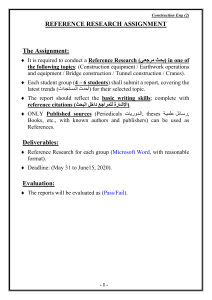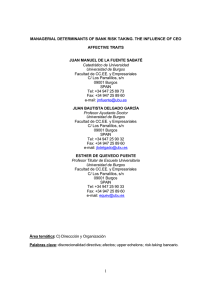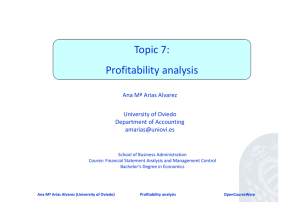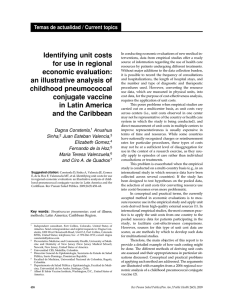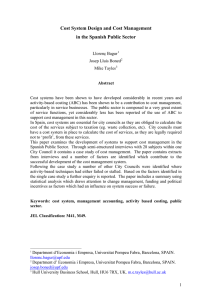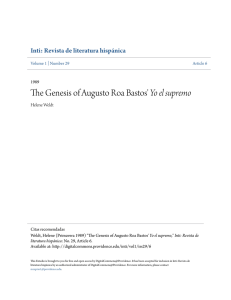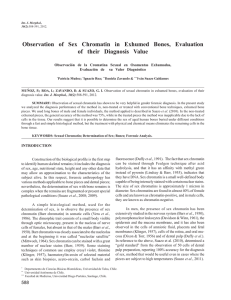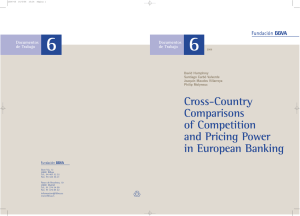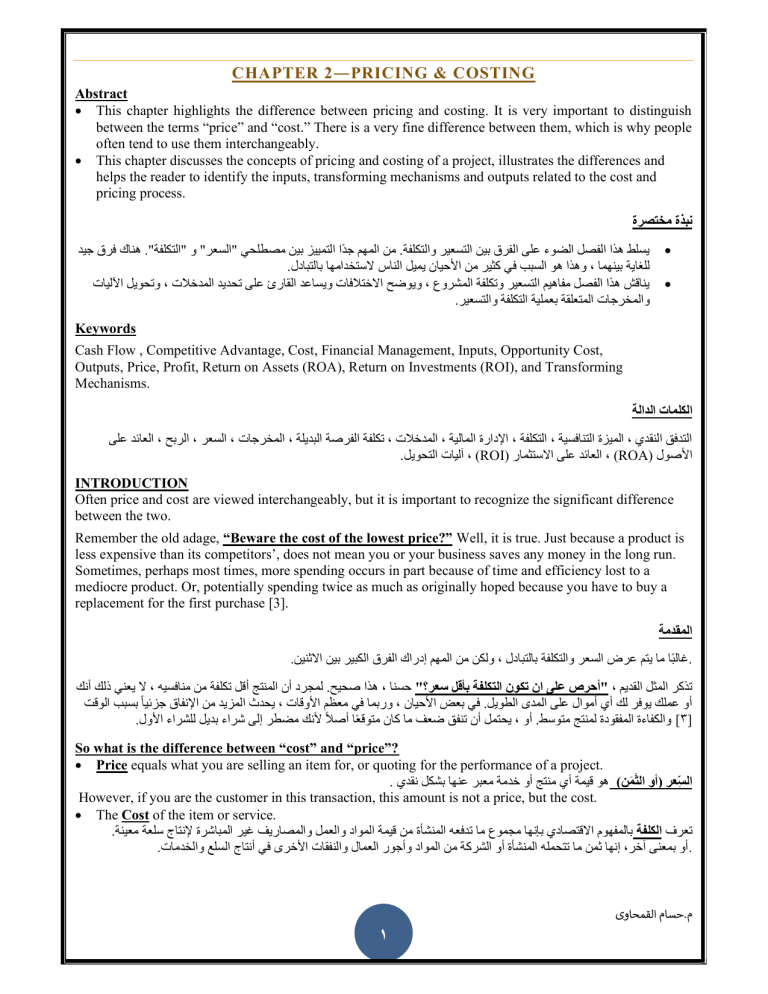
CHAPTER 2―PRICING & COSTING Abstract This chapter highlights the difference between pricing and costing. It is very important to distinguish between the terms “price” and “cost.” There is a very fine difference between them, which is why people often tend to use them interchangeably. This chapter discusses the concepts of pricing and costing of a project, illustrates the differences and helps the reader to identify the inputs, transforming mechanisms and outputs related to the cost and pricing process. نبذة مختصرة هناك فرق جيد." من المهم جدًا التمييز بين مصطلحي "السعر" و "التكلفة.يسلط هذا الفصل الضوء على الفرق بين التسعير والتكلفة . وهذا هو السبب في كثير من اﻷحيان يميل الناس ﻻستخدامها بالتبادل، للغاية بينهما وتحويل اﻵليات، ويوضح اﻻختﻼفات ويساعد القارئ على تحديد المدخﻼت، يناقش هذا الفصل مفاهيم التسعير وتكلفة المشروع .والمخرجات المتعلقة بعملية التكلفة والتسعير Keywords Cash Flow , Competitive Advantage, Cost, Financial Management, Inputs, Opportunity Cost, Outputs, Price, Profit, Return on Assets (ROA), Return on Investments (ROI), and Transforming Mechanisms. الكلمات الدالة العائد على، الربح، السعر، المخرجات، تكلفة الفرصة البديلة، المدخﻼت، اﻹدارة المالية، التكلفة، الميزة التنافسية، التدفق النقدي . آليات التحويل، (ROI) العائد على اﻻستثمار، (ROA) اﻷصول INTRODUCTION Often price and cost are viewed interchangeably, but it is important to recognize the significant difference between the two. Remember the old adage, “Beware the cost of the lowest price?” Well, it is true. Just because a product is less expensive than its competitors’, does not mean you or your business saves any money in the long run. Sometimes, perhaps most times, more spending occurs in part because of time and efficiency lost to a mediocre product. Or, potentially spending twice as much as originally hoped because you have to buy a replacement for the first purchase [3]. المقدمة . ولكن من المهم إدراك الفرق الكبير بين اﻻثنين، غالبًا ما يتم عرض السعر والتكلفة بالتبادل. ﻻ يعني ذلك أنك، لمجرد أن المنتج أقل تكلفة من منافسيه. هذا صحيح، "أحرص على ان تكون التكلﻔة ﺑﺄﻗﻞ ﺳﻌر؟" حسنا، تذكر المثل القديم يحدث المزيد من اﻹنفاق جزئيا ً بسبب الوقت، وربما في معظم اﻷوقات، في بعض اﻷحيان.أو عملك يوفر لك أي أموال على المدى الطويل . يحتمل أن تنفق ضعف ما كان متوقعًا أصﻼً ﻷنك مضطر إلى شراء بديل للشراء اﻷول، أو.[ والكفاءة المفقودة لمنتج متوسط٣] So what is the difference between “cost” and “price”? Price equals what you are selling an item for, or quoting for the performance of a project. . سﻌر )أو الث َ َمن( هو قيمة أي منتج أو خدمة معبر عنها بشكل نقدي ّ ِ ال However, if you are the customer in this transaction, this amount is not a price, but the cost. The Cost of the item or service. .تعرف الكلﻔة بالمفهوم اﻻقتصادي بإنها مجموع ما تدفعه المنشأة من قيمة المواد والعمل والمصاريف غير المباشرة ﻹنتاج سلعة معينة . إنها ثمن ما تتحمله المنشأة أو الشركة من المواد وأجور العمال والنفقات اﻷخرى في أنتاج السلع والخدمات، أو بمعنى آخر. حسام القمحاوى.م ١ What it comes down to for most major purchase decisions is Return on Investment (ROI). Where do you stand to gain the biggest bang for the buck [3]? In business, The price of a widget is what it can sell for, while The cost is how much is spent to make one. Profit is the difference between the two, determining the success or failure of a business [4]. [؟٣] أين تقف لكسب أكبر فرق للباك؟.(ROI) ما يتعلق اﻷمر بمعظم قرارات الشراء الرئيسية هو العائد على اﻻستثمار الربح هو الفرق. في حين أن التكلفة هي المبلغ الذي يتم إنفاقه لصنعه، فإن سعر القطعة هو ما يمكن بيعه، في مجال اﻷعمال التجارية . وتحديد نجاح أو فشل اﻷعمال التجارية، بين اﻻثنين Price = Cost + Profit Pricing and costing are terms which are not the same, but are commonly used interchangeably in economics, finance and project management, and even among cost engineering practitioners. Clarity of these terms is one of the objectives of this chapter. This is best achieved by its application to cost engineering in the Engineering, Procurement, and Construction (EPC) Industry for capital acquisitions and/or improvements, and by relating the terminologies to the cost-pricing process based on AACE International’s TCM Framework. The basis of the cost and pricing process is the analysis of the inputs, transforming mechanisms, and the ensuing outputs or deliverables. The transforming mechanisms (tools and techniques) address both the cost engineering and business economic perspectives. وحتى، ولكنها شائعة اﻻستخدام بالتبادل في اﻻقتصاد والمالية وإدارة المشاريع، التسعير والتكلفة عبارة عن مصطلحات ليست متشابهة .بين ممارسي هندسة التكلفة يمكن تحقيق ذلك على أفضل وجه من خﻼل تطبيقه على هندسة التكاليف في الهندسة. وضوح هذه الشروط هو أحد أهداف هذا الفصل وربط المصطلحات بعملية تسعير التكلفة بنا ًء على اﻹطار، أو التحسينات/ والمشتريات وصناعة البناء لﻼستحواذ على رأس المال و .الدولي . أساس عملية التكلفة والتسعير هو تحليل المدخﻼت وآليات التحويل والنواتج أو النواتج التالية . آليات التحويل )اﻷدوات والتقنيات( تتناول كﻼً من المنظورات اﻻقتصادية والهندسة اﻻقتصادية The cost engineering perspective which establishes the costing/pricing strategies, the business economic perspective can also be considered such as the financial ratios calculated from the financial data. Both perspectives are important to the transforming mechanisms (tools and techniques) for the costing and pricing process. يمكن أيضًا اعتبار منظور اﻻقتصاد التجاري مثل النسب المالية، التسعير/ منظور هندسة التكلفة الذي يحدد استراتيجيات تقدير التكاليف .المحسوبة من البيانات المالية . كﻼ المنظورين مهمان ﻵليات التحويل )اﻷدوات والتقنيات( لعملية تقدير التكاليف والتسعير There are many reasons that cost engineers and cost controllers need to understand the financial ratio. The main reason is that the ratio establishes another set of tools and techniques for improving the cost decision process on projects at any phase of execution. Using financial ratios provides a quick method for project personnel to sort through financial information that is available in the financial reports. السبب الرئيسي هو أن النسبة تحدد مجموعة.هناك العديد من اﻷسباب التي تج عل مهندسي التكلفة ومراقبي التكلفة بحاجة إلى فهم النسبة المالية يوفر استخدام النسب المالية.أخرى من اﻷدوات والتقنيات لتحسين عملية اتخاذ قرار التكلفة على المشاريع في أي مرحلة من مراحل التنفيذ .طريقة سريعة لموظفي المشرو ع للفرز من خﻼل المعلومات المالية المتوفرة في التقارير المالية Outputs are the deliverable of the process and can include items such as the completion of an estimate or the acquisition of a contract or project. Obtaining the best possible inputs, combined with optimizing the transforming mechanisms, is essential to these critical deliverables. يعد الحصول على أفضل.المخرجات هي نتائج العملية ويمكن أن تشمل عناصر مثل إكمال التقدير أو الحصول على عقد أو مشروع .أمرا ضروريًا في هذه النتائج المهمة ً ، إلى جانب تحسين آليات التحويل، المدخﻼت الممكنة Learning Objectives After completing this chapter, the reader should be able to: Differentiate between costing and pricing. Identify the inputs, transforming mechanisms and outputs related to the costing and pricing process. حسام القمحاوى.م ٢ Understand the budgeting process. Calculate financial ratios related to the costing and pricing of projects. Understand the reasoning behind the costing and pricing process outputs. -:قادرا على ً يجب أن يكون القارئ، بعد اﻻنتهاء من هذا الفصل .•التمييز بين التكاليف والتسعير . وتحويل اﻵليات والمخرجات المتعلقة بعملية تقدير التكاليف والتسعير، • تحديد المدخﻼت .•فهم عملية وضع الميزانية .•حساب النسب المالية المتعلقة بتكلفة وتسعير المشاريع .•فهم المنطق وراء النواتج عملية تقدير التكاليف والتسعير COSTING AND PRICING In researching definitions of costing and pricing from various sources, clear differences were found in business and economics, namely in terms of a buyer and a seller. Costing and pricing are presented here from the cost estimating perspective. التكلﻔة واﻷﺳﻌار أي من حيث المشتري، تم العثور على اختﻼفات واضحة في اﻷعمال واﻻقتصاد، في البحث عن تعريفات للتكاليف والتسعير من مصادر مختلفة . يتم عرض التكاليف والتسعير هنا من منظور تقدير التكلفة.والبائع 1. Pricing Pricing can be defined as the determination of the amount to be charged to the client, so as to fully include everything necessary to provide a service or product, plus profit. Therefore, the cost includes all direct and indirect cost, plus any allowable contingency. In cost estimating, pricing a project follows cost. بحيث يشمل بشكل كامل كل ما هو ضروري لتقديم خدمة أو، يمكن تعريف التسعير على أنه تحديد المبلغ المراد تحميله على العميل . باﻹضافة إلى الربح، منتج يتبع تسعير المشروع، عند تقدير التكلفة. باﻹضافة إلى أي طارئ مسموح به، تتضمن التكلفة جميع التكاليف المباشرة وغير المباشرة، لذلك .التكلفة حسام القمحاوى.م ٣ Table 2.1: Project Cost versus Price-Example:Project SOW (Scope of Work) Cost Field Office Overheads (6%) Home Office Overheads (10%) Project Cost Subtotal Contingency (5%) Project Total Cost Profit (10%) Project Total Price $1,000,000 $60,000 $100,000 $1,160,000 $58,000 $1,218,000 $121,800 $1,339,800 2. Costing Defining cost can become confusing for some, as they become entangled in accounting and business economics (e.g., COGS-cost of goods sold and fixed, variable and sunk costs) terminologies. Clarifying this terminology by relating it to the cost estimating process is recommended for cost engineering professionals. حيث يصبحون متشابكين في المصطلحات اﻻقتصادية واقتصاديات اﻷعمال )على سبيل، يمكن أن يصبح تعريف التكلفة مرب ًكا بالنسبة للبعض .( للسلع المباعة والتكاليف الثابتة والمتغيرة والمغمورةCOGS تكلفة، المثال .يوصى بتوضيح هذه المصطلحات من خﻼل ربطها بعملية تقدير التكاليف للمهنيين المتخصصين في هندسة التكلفة In the cost estimating process, costing follows scope determination and quantification and precedes pricing and budgeting (see S&K6Chapter 9, Cost Estimating) [1]. This concept is also substantiated by the TCM Framework. “You cost the scope contents and price the cost estimate” (see TCM Framework, p.42) [4]. Based on the cost estimating process, cost can be categorized into direct or indirect cost (see S&K6 Chapter 9, Cost Estimating) (Figure 2.1) [1]. .[١] ( تقدير التكلفة، ٩ الفصلS & K6 تتبع التكلفة تحديد النطاق وتحديده قبل التسعير والميزانية )انظر، في عملية تقدير التكلفة ( تقدير التكلفة، S & K6 و٩ يمكن تصنيف التكلفة إلى تكلفة مباشرة أو غير مباشرة )انظر الفصﻼن، استنادًا إلى عملية تقدير التكلفة .[١] (٢٫١ )الشكل Direct costs are those that are specific and tangible to the project, and include the costs of materials, labor, equipment, etc. . إلخ، وتشمل تكاليف المواد والعمالة والمعدات، التكاليف المباشرة هي تلك المحددة والملموسة للمشروع Indirect costs are those costs not directly accountable or tangible to the project, such as business taxes, home office overhead, or transportation fleet distributed cost, but necessary for the business to remain solvent. مثل الضرائب التجارية أو النفقات العامة، التكاليف غير المباشرة هي تلك التكاليف التي ﻻ تخضع للمساءلة المباشرة أو الملموسة للمشروع . ولكنها ضرورية ﻷن تظل اﻷعمال التجارية مذيبًا، بالمكتب المنزلي أو التكلفة الموزعة ﻷسطول النقل حسام القمحاوى.م ٤ the costinG-pricinG process inputs The main input to the costing-pricing process is the scope, such as equipment, for which the cost needs to be determined; or the systems (mechanical, electrical, and plumbing (MEP)) related to the project that has to be priced. In costing, the individual items that comprise the historical records of a system or process along with previous projects data will be beneficial for comparison purposes. Vendor quotations provide a more current value of the cost and final price of the equipment and system. المدخﻼت التي تحتاج إلى تحديد التكلفة ؛ أو اﻷنظمة( الميكانيكية والكهربائية، مثل المعدات، إن المدخل الرئيسي لعملية تسعير الكلفة هو النطاق .( المتعلقة بالمشروع الذي يجب تسعيرهMEP)) .والسباكة فإن العناصر الفردية التي تتضمن السجﻼت التاريخية لنظام أو عملية إلى جانب بيانات المشاريع السابقة ستكون، عند تقدير التكاليف .مفيدة ﻷغراض المقارنة . توفر أسعار البائعين قيمة أكثر حداثة للتكلفة والسعر النهائي للمعدات والنظام WBS/scope Historical records Vendor quotations النطاق/ WBS • • السجﻼت التاريخية • عروض البائعين أ- WBS/Scope a. The scope of work incorporates all the documents and relevant drawings and specifications that form the basis of the scope. b. The Work Breakdown Structure (WBS) provides a structure with increasing levels of functional decomposition of scope from top to bottom. c. At the bottom level of the WBS the elements of the scope are cost coded. It is at this level of the WBS that costing, and consequently, pricing occurs. d. Here is a great example where cost and price comingle in the estimate. The purchased equipment delivered to the job site represents a price in the estimate, as well as any subcontracted scope by other sub-vendors and contractors such as the MEP. While these items represent pricing, they are still cost in the general contractor’s cost estimate. نطاق/ WBS . يتضمن نطاق العمل جميع المستندات والرسومات والمواصفات ذات الصلة التي تشكل أساس النطاق-أ ً .هيكﻼ ذا مستويات متزايدة من التحلل الوظيفي للنطاق من اﻷعلى إلى اﻷسفل (WBS) توفر بنية تجزئة العمل-ب . يتم تحديد التكلفة وبالتالي حدوث التسعير، WBS عند هذا المستوى من. يتم ترميز عناصر النطاق، WBS في المستوى السفلي من-ت حسام القمحاوى.م ٥ وكذلك، تمثل المعدات المشتراة التي تم تسليمها إلى موقع العمل ثمنا ً في التقدير. فيما يلي مثال رائع حيث التكلفة والسعر يأتي في التقدير-ث فهي ﻻ تزال، في حين أن هذه العناصر تمثل التسعير.MEP أي نطاق تم التعاقد عليه من الباطن من قبل الباعة والمقاولين اﻵخرين مثل .تكلفة في تقدير تكلفة المقاول العام ---------------------------------------------------------------------------------------------------------------------------------ب- Historical Records According to the TCM Framework, project historical records referred to as, “historical database management,” is a process for collecting, maintaining, and analyzing project historical information so that it is ready and available for use by other project control processes. Project historical records for costing and pricing a project includes, but is not limited to, the following documents from similar previous projects. السجﻼت التاريخية عملية لجمع وصيانة، " تعد السجﻼت التاريخية للمشروع والمشار إليها باسم "إدارة قاعدة البيانات التاريخية، TCM وفقًا ﻹطار عمل .وتحليل المعلومات التاريخية للمشروع بحيث تكون جاهزة ومتاحة لﻼستخدام من قبل عمليات مراقبة المشروع اﻷخرى المستندات التالية من مشاريع سابقة، على سبيل المثال ﻻ الحصر، تتضمن السجﻼت التاريخية للمشروع لتقدير تكلفة المشروع وتسعيره .مماثلة Work Breakdown Structure. Quantity take-offs or quantity surveys. Schedules. Cost reports, which would show the costing data. Bid Documents, which would indicate the pricing information. .• انهيار الهيكل العمل .• كميات اﻹقﻼع أو استطﻼعات الكمية .• جداول . والتي من شأنها أن تظهر بيانات التكلفة، • تقارير التكلفة . والتي من شأنها أن تشير إلى معلومات التسعير، • وثائق العطاء The objective of using historical records is to enable continuous improvement and mitigate risk in the project installed systems based on lessons learned from previous projects. الهدف من استخدام السجﻼت التاريخية هو تمكين التحسين المستمر وتخفيف المخاطر في اﻷنظمة المثبتة بالمشروع بنا ًء على الدروس .المستفادة من المشاريع السابقة -----------------------------------------------------------------------------------------------------------------------------ت- Vendor Quotations a. In coordination with the procurement and contracts department, those vendors that are being considered for major equipment purchases on the project are contacted for vendor quotations. b. The cost elements for major equipment quotations are generally for items such as: mechanical equipment inclusive of compressors, heat exchangers, condensers, or major electrical equipment. c. The cost elements are specific to the type of projects and the strategy of construction (modularization versus non-modularization). d. Vendors are contacted to provide a current estimate of these elements, which provides a current estimate of the cost of the major cost items. e. This is an important step that helps in qualifying the level of accuracy of the estimate. f. As stated earlier, a vendor estimate or quote is a price, not a cost. g. Hence, the vendor sells the equipment for a price and the installation contractor or facility owner receives the equipment as a cost to their project. عروض أﺳﻌار البائﻌين يتم اﻻتصال بهؤﻻء البائعين الذين يتم النظر في شرائهم للمعدات الرئيسية في المشروع، بالتنسيق مع إدارة المشتريات والعقود .للحصول على عروض أسعار البائعين -أ حسام القمحاوى.م ٦ ب -تكون عناصر تكلفة عروض أسعار المعدات الرئيسية عمو ًما لعناصر مثل :المعدات الميكانيكية بما في ذلك الضواغط أو المبادﻻت الحرارية أو المكثفات أو المعدات الكهربائية الرئيسية. ت -عناصر التكلفة محددة لنوع المشاريع واستراتيجية البناء )التقنينية مقابل غير النموذجية(. تقديرا حاليًا لتكلفة عناصر التكلفة الرئيسية. ث -يتم اﻻتصال بالموردين لتوفير تقدير حالي لهذه العناصر ،والذي يوفر ً ج -هذه خطوة مهمة تساعد في تأهيل مستوى دقة التقدير. ح -كما ذكرنا سابقًا ،فإن تقدير أو عرض البائع هو سعر وليس تكلفة. خ -وبالتالي ،يقوم البائع ببيع الم عدات مقابل سعر ويتلقى مقاول التثبيت أو مالك المنشأة المعدات كتكلفة لمشروعهم. ---------------------------------------------------------------------------------------------------------------------------------- ) transforminG mechanism (tools and techniques The tools and techniques are methodologies applied to costing and pricing to produce an optimal outcome, be it an estimate, a project, or a business decision. With the complexities involved, it should not come as a surprise that pricing is considered an art by many cost managers [5]. Establishing the right intelligence information on customer cost budgets and competitive pricing is an essential element in this part of pricing. A disciplined approach that is derived from combining the cost engineering and business valuation is very beneficial. This approach involves the following tools and techniques:- آلية التحويﻞ )اﻷدوات والتقنيات( قرارا تقديرا أم مشروعًا أم اﻷدوات والتقنيات هي منهجيات مطبقة على تقدير التكاليف والتسعير للحصول على أفضل نتيجة ،سواء أكان ذلك ً ً تجاريًا .مع التعقيدات التي تنطوي عليها ،ﻻ ينبغي أن يكون مفاجأة أن التسعير يعتبر فنًا من قبل العديد من مديري التكاليف ] .[٥يعد إنشاء المعلومات اﻻستخبارية الصحيحة حول ميزانيات تكلفة العمﻼء واﻷسعار التنافسية عنصرا ً أساسيا ً في هذا الجزء من التسعير .يعد النهج المنضبط المستمد من الجمع بين هندسة التكلفة وتقييم اﻷعمال مفيدًا جدًا .يتضمن هذا النهج اﻷدوات والتقنيات التالية- : 1. costinG and pricinG strateGies 2. financial analYsis .١تقدير التكاليف واستراتيجيات التسعير .٢تحليل مالي 1. costinG and pricinG strateGies include: A. Cost estimating B. Budgeting C. Cost forecasting تشمﻞ اﺳتراتيجيات التكلﻔة والتسﻌير ما يلي: • تقدير التكاليف • الميزنة • التنبؤ التكلفة A. Cost Estimating a. Cost estimating involves the application of techniques that translate quantities into financial and resource information. (See TCM Framework, p.177) [2]. b. The outputs of cost estimating are used as primary inputs, not only for business planning, but for the project cost and schedule control processes. c. The budgeting process is the technique used to transform the cost elements into a monitoring and controlling tool. أ- تقدير التكلﻔة .١يشمل تقدير التكلفة تطبيق التقنيات التي تترجم الكميات إلى معلومات مالية ومعلومات عن الموارد) .انظر ، TCM Framework ص .[٢] (١٧٧. .٢تُستخدم مخرجات تقدير التكلفة كمدخﻼت أولية ،ليس فقط لتخطيط اﻷعمال ،ولكن أيضًا لتكاليف المشروع وعمليات التحكم بالجدول الزمني. .٣عملية وضع الميزانية هي التقنية المستخدمة لتحويل عناصر التكلفة إلى أداة مراقبة ومراقبة. B. Budgeting The inputs to the budget development process include:a. Activity Cost Estimates―The hours and dollars associated with each cost activity. م.حسام القمحاوى ٧ b. Scope Baseline―The WBS and scope-based on drawings, specifications, previous documents and expert opinion. c. Project Schedule―An initial schedule that would provide an indication of cash flow. d. Contracts―Contract strategy information, indicating direct labor cost versus contract costs planned for the project. الموازنة -ث - :تشمل المدخﻼت في عملية وضع الميزانية ما يلي . تقديرات تكلفة النشاط ― الساعات والدوﻻرات المرتبطة بكل نشاط التكلفة.١ . والنطاق القائم على الرسومات والمواصفات والوثائق السابقة وآراء الخبراءW WBS النطاق اﻷساسي.٢ . جدول المشروع ― جدول أولي من شأنه أن يوفر إشارة إلى التدفق النقدي.٣ . تشير إلى تكلفة اليد العاملة المباشرة مقابل تكاليف العقد المخططة للمشروع، معلومات استراتيجية العقد- العقود.٤ From these inputs, a budget is established broken down to the activities level. The budget process is then set up and includes: Monthly review and evaluation of the budget cost items; A change control process that documents and controls changes to the budget; and, A monthly forecast that indicates predicted budget overrun/underrun. : يتم بعد ذلك إعداد عملية الميزانية وتشمل. يتم وضع ميزانية مقسمة إلى مستوى اﻷنشطة، من هذه المدخﻼت • المراجعة والتقييم الشهري لبنود تكلفة الميزانية ؛ ،• عملية مراقبة التغيير التي توثق وتضبط التغييرات في الميزانية ؛ و . تنبؤات الميزانية المتوقعة/ • توقعات شهرية تشير إلى تجاوز C. Cost Forecasting In order to forecast final cost, a forecasting technique called the earned value method is applied. This methodology establishes, on a Periodic basis (monthly in most cases), the following (Refer to S&K6 Chapter 14, Earned Value Overview) [1]: التنبؤ ﺑالتكلﻔة-ج . يتم تطبيق تقنية تنبؤ تسمى طريقة القيمة المكتسبة، من أجل التنبؤ بالتكلفة النهائية ( نظرة عامة على القيمة المكتسبة، ١٤ الفصلS & K6 ما يلي )راجع، ( على أساس دوري )شهريًا في معظم الحاﻻت، تحدد هذه المنهجية -:[١] The Estimate at Completion (EAC), which is based on the earned value Cost Performance Index (CPI), plus actual cost to date and the Estimate to Complete (ETC). Predicts an overrun in cost if the EAC cost value is higher than the Budget at Completion (BAC). The Cost Performance Index (CPI) is also provided for each work package, as indicated in the EAC value development. باﻹضافة إلى التكلفة الفعلية حتى اﻵن والتقدير، (CPI) والذي يعتمد على القيمة المكتسبة من مؤشر أداء التكلفة، (EAC) • التقدير عند اﻹكمال .(ETC) إلى اﻹكمال .(BAC) أعلى من الميزانية عند اﻻنتهاءEAC • يتوقع تجاوز في التكلفة إذا كانت قيمة تكلفة .EAC كما هو موضح في تطوير قيمة، ( أيضًا لكل حزمة عملCPI) • يتم توفير مؤشر أداء التكلفة ---------------------------------------------------------------------------------------------------------------------------------- 2. financial manaGement a. Return on Investment b. Return on Assets c. Net Profit Margin اﻹدارة المالية.٢ . العائد على اﻻستثمار-أ . العائد على اﻷصول-ب . هامش صافي الربح-ت Return on Investment (ROI) and Return on Assets (ROA) measures profitability of a company on its investment and assets respectively. حسام القمحاوى.م ٨ Calculating the ROI provides a better understanding about the cost effectiveness of a project. ROA, when applied to projects, is typically used as a technique for project acceptance, or as a tool to evaluate overall performance. Companies having a choice of different projects would prefer those projects showing a higher ROA. Return on Assets is best used for comparing projects within the same industry. .( يقيس ربحية الشركة على استثماراتها وأصولها على التواليROA) ( والعائد على اﻷصولROI) العائد على اﻻستثمار .يوفر حساب العائد على اﻻستثمار فهما ً أفضل لفعالية تكلفة المشروع . أو كأداة لتقييم اﻷداء الكلي، كأسلوب لقبول المشروع، عند تطبيقه على المشروعات، ROA يستخدم .تفضل الشركات التي لديها اختيار لمشاريع مختلفة تلك المشاريع التي تظهر أعلى عائد على اﻻستثمار .من اﻷفضل استخدام العائد على اﻷصول لمقارنة المشاريع داخل نفس الصناعة Net Profit Margin is a measure of the effectiveness of a company at cost controlling. Depending on the manner in which the company's financial system is organized (i.e., costs are organized by function rather than by project), it may be difficult to ascertain the net profit for specific project(s). However, by judicious selection of appropriate accounts, a reasonable overall margin can be estimated. . صافي هامش الرﺑح هو مقياس لفعالية الشركة في مراقبة التكاليف قد، ( يتم تنظيم التكاليف حسب الوظيفة وليس عن طريق المشروع، اعتمادًا على الطريقة التي يتم بها تنظيم النظام المالي للشركة )أي .يكون من الصعب التحقق من صافي الربح لمشروع محدد )مشاريع( محددة . يمكن تقدير هامش شامل معقول، من خﻼل اﻻختيار الدقيق للحسابات المناسبة، ومع ذلك a. Return on Investment (ROI) Calculating simple ROI, for cash flow and capital investment analysis, measures the profitability in dollars invested. It is easy to understand and simple to use. It works well in situations where both the profits from the projects and the costs of the investment are easily known. Investments yielding a higher ROI will be the better investment; however, this calculation does not recognize any risk factor. Benefits are returns on the investment coming in as a result of the investment made into the project. (See Table 2.2). (ROI) الﻌائد على اﻻﺳتثمار إنه سهل الفهم وسهل. ويقيس الربحية بالدوﻻر المستثمر، للتدفق النقدي وتحليل رأس المال اﻻستثمار، حساب العائد على اﻻستثمار بسيط اﻻستثمارات التي تحقق عائد. إنه يعمل بشكل جيد في الحاﻻت التي يكون من السهل فيها معرفة كل من اﻷرباح وتكاليف اﻻستثمار.اﻻستخدام الفوائد هي عوائد اﻻستثمار القادمة كنتيجة. هذا الحساب ﻻ يتعرف على أي عامل خطر، استثمار أعلى ستكون اﻻستثمار اﻷفضل ؛ ومع ذلك .(٢٫٢ )انظر الجدول.لﻼستثمار الذي تم في المشروع حسام القمحاوى.م ٩ b. Net Profit Margin The net profit margin is equal to the net income after taxes and excluding extraordinary items divided by total revenues; and is a measure of the effectiveness of a company at cost control. (See Table 2.3) هامش صافي الرﺑح هامش الربح الصافي يساوي صافي الدخل بعد الضرائب وباستثناء البنود اﻻستثنائية مقسومة على إجمالي اﻹيرادات ؛ وهو مقياس لفعالية .(٢٫٣ )انظر الجدول.الشركة في مراقبة التكاليف ---------------------------------------------------------------------------------------------------------------------------------c. Return on Assets (ROA) This number tells you how effective your business has been at putting its assets to work. The ROA is a test of capital utilization – how much profit (before interest and income tax) a business earned on the total capital expended to achieve that profitability. ROA is recognized here to determine the anticipated return from a project. ROA is also applied to determine the viability of a project. Projects may not be considered viable in which the ROA is lower than the cost of funding the project. ROA is a ratio of the earnings generated from a project compared to the assets spent to generate that revenue. (See Table 2.3). (ROA) الﻌائد على اﻷصول مقدار اﻷرباح )قبل ضريبة الدخل- عبارة عن اختبار ﻻستخدام رأس المالROA إن.يخبرك هذا الرقم بمدى فعالية عملك في تشغيل أصوله هنا لتحديد العائد المتوقع منROA يتم التعرف على.والدخل( التي حققتها الشركة من إجمالي رأس المال الذي تم إنفاقه لتحقيق هذه الربحية ﻻ يمكن اعتبار المشروعات قابلة للتطبيق حيث يكون معدل العائد على. أيضًا لتحديد مدى صﻼحية المشروعROA يتم تطبيق.المشروع عائد اﻻستثمار هو نسبة اﻷرباح الناتجة من مشروع مقارنة باﻷصول التي يتم إنفاقها لتوليد تلك.اﻻستثمار أقل من تكلفة تمويل المشروع .(٢٫٣ )انظر الجدول.اﻹيرادات حسام القمحاوى.م ١٠ outputs The outputs of this process represent the documents that bring closure to the costing and pricing process and include: 1. Project estimate 2. Project acquisition 3. Business decision المخرجات :تمثل مخرجات هذه العملية المستندات التي تحقق اﻹغﻼق لعملية تحديد السعر والتسعير وتشمل تقدير المشروع.١ اقتناء المشروع.٢ قرار اﻷعمال.٣ 1. Project Estimate This is a deliverable based on the culmination of the costing and pricing processes. The costing process involves developing the cost estimate and budget. The pricing process establishes the all-inclusive pricing of the project taking into account profitability. تقدير المشروع تحدد عملية. تتضمن عملية تقدير التكاليف تطوير تقدير التكلفة والميزانية.هذا هو التسليم على أساس تتويجا لعمليات تقدير التكاليف والتسعير .التسعير التسعير الشامل للمشروع مع مراعاة الربحية 2. Project Acquisition and Business Decision Establishing a price for the project is only one of the parameters that need to be addressed in project acquisition and business decision, as the financial ratios need to be used to address the validity of the acquisition. These ratios are: Return on Assets (ROA) Return on Investment (ROI) Net Profit Margin اﻗتناء المشروع وﻗرار الﻌمﻞ حيث يجب استخدام، إن تحديد سعر للمشروع هو فقط أحد البارامترات التي يجب معالجتها في عملية حيازة المشروع وقرار العمل : هذه النسب هي.النسب المالية لمعالجة صحة عملية اﻻستحواذ .(ROA) • العائد على اﻷصول .(ROI) • العائد على اﻻستثمار .• هامش صافي الربح حسام القمحاوى.م ١١
